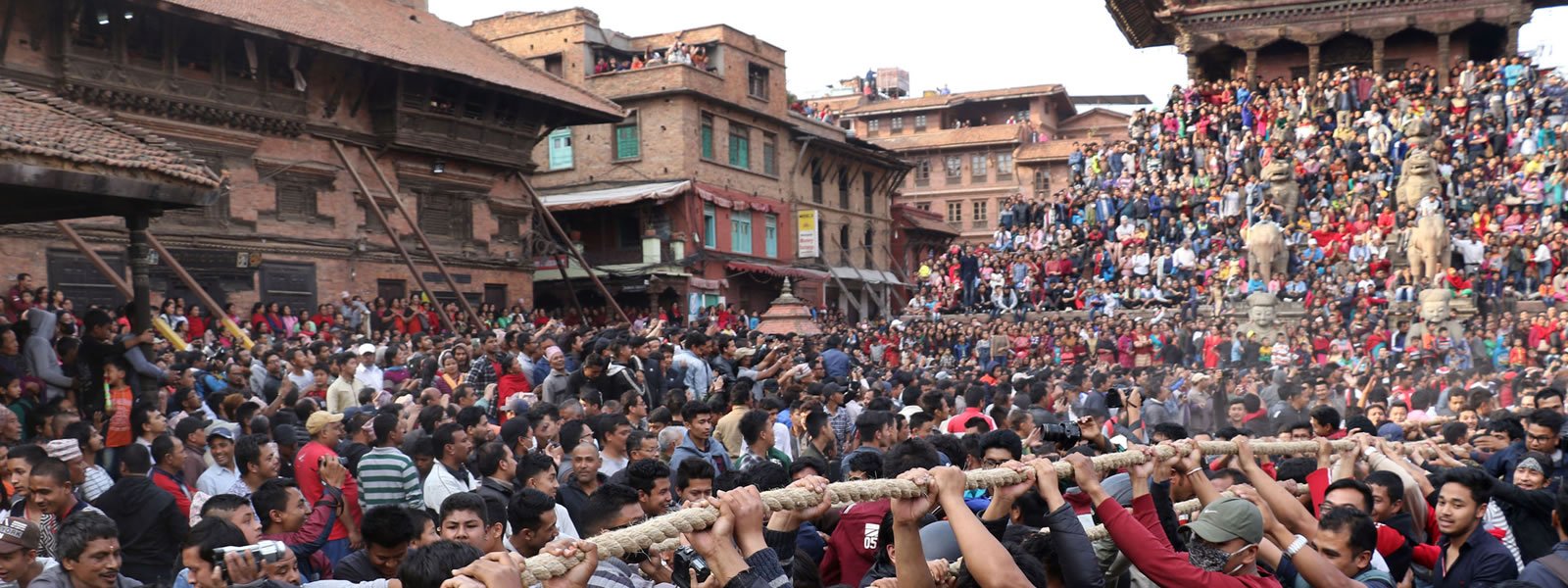Biska Jatra in Nepal

- 12-Jun-2021
- 0
Bisket Jatra or Biska Jatra Jibro Chhedne Jatra or Sindoor Jatra is a weeklong festival of Bhaktapur( the smallest district of Nepal lies 12 kilometers away from Kathmandu) marks the ancient solar Naya Barsha (New Year) and is the only festival that rejects the lunar-based Nepali calendar.
The Bisket Jatra signifies the termination of the Nepalese month of Chaitra and the start of a New Nepali Year in Baisakh, summonses everyone in and around Bhaktapur to celebrate the exuberant moment together utterly. Moreover, the Jatra inaugurated a special Tantric ritual in the Bhairab temple in Taumadhi Tole in Bhaktapur.
The well-known carnival, which is watched for eight evenings and nine days, designated by certifiable records it has been practicing since the Lichchavi time, the Jatra began revering Bhairabi sanctuary adjacent Paanchtale sanctuary in Taumadi.
A chariot parade is held in Bhaktapur during the celebration, and pictures of Ganesh, Lakshmi, and Mahakali are taken to the town. The Bisket Jatra grades a social glee in Bhaktapur. Strikingly the coming of spring is a merriment of human feelings typically outlined through the different parts of the celebration.
An interesting legend is behind the celebration of this festival. As it goes, it is about the massacring of a couple of serpents by a nice-looking young fellow using his tantric powers. Those snakes were the cause of the expiry of the previous grooms.
It is said that the two snakes left the nostrils of an excellent princess when she gasped in the middle of the night. In the twinkling of an eye, they transformed into terrific serpents. When they were going to attack the young lad, he slaughtered them, employing his tantric forces. The two Raths resemble two snakes and lied down, showing they now cannot harm.
 During the main day, Bhairav (famous tantric of Hindu deity) and Bhadrakali (is the fierce form of Kali that protects the good from the evil) are then placed in large chariots (locally known as Raths) and pulled through troops of reassuring bystanders. Thus, people rerun a drama passed on several centuries.
During the main day, Bhairav (famous tantric of Hindu deity) and Bhadrakali (is the fierce form of Kali that protects the good from the evil) are then placed in large chariots (locally known as Raths) and pulled through troops of reassuring bystanders. Thus, people rerun a drama passed on several centuries.
The Raths are paused for a Tug of War between the eastern and western sides of the city and then move down steep streets leading to a river. A 25m tall vertical pole (Lingam- phallic symbol) is instituted in the stone yoni (female genital symbol) base in the river (Lingam- phallic symbol). In the evening the next day, the pole is pulled down again in the tug of war. Finally, when the pole smashes on the ground, the official New Year begins.
 The folklore behind the Bhairawa and Bhadrakali is also thought-provoking. Bhairawa and Bhadrakali are considered the male and female types of the atmosphere and the Earth, respectively. It is believed that the conjugation of the sky and the earth made the creation conceivable on this planet. The shower from the sky on the earth is taken as the nurturing component, and the planet is the foundation of every new creation.
The folklore behind the Bhairawa and Bhadrakali is also thought-provoking. Bhairawa and Bhadrakali are considered the male and female types of the atmosphere and the Earth, respectively. It is believed that the conjugation of the sky and the earth made the creation conceivable on this planet. The shower from the sky on the earth is taken as the nurturing component, and the planet is the foundation of every new creation.




